Rocco’s Island: Ring to End the Pain review
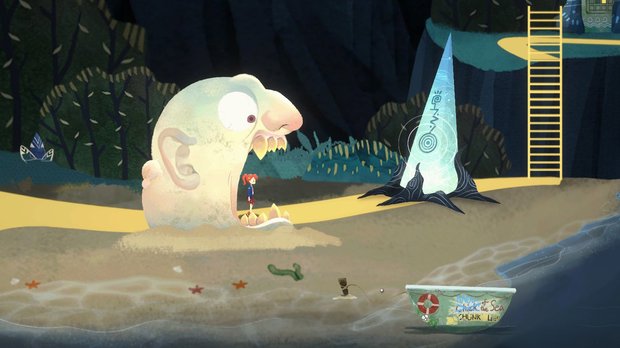
- 2 Comments
Casual hybrid suffers from a poor match of gameplay styles
I won’t mince words: Rocco’s Island: Ring to End the Pain is not fun. It’s beautiful to look at, just not an enjoyable time. And if I could get away with just that sentence as a review, I’d leave it there. But since a little explanation is in order, I’ll elaborate on exactly why almost nothing in Rocco’s Island works as a game.
Let’s start with what’s good: I love the graphics. The entire adventure takes place on a massive, scrolling overworld that looks like it could have come straight out of a Tomm Moore movie (The Secret of Kells, Song of the Sea, Wolfwalkers). The art is digitally painted with sketchy lines, moody colors, and tons of magical detail that make you feel like you’re in a fantasy world. When you, playing as a young red-headed girl in a torn school uniform, first wake up on a strange island, the visuals will most likely grab you and wrap you in a fairy tale blanket of comfort. Talking animals, a lush forest, a majestic ice castle on top of a mountain… It feels cozy, but filled with interesting things to see.
To its credit, the game has a lot of details to explore. One of the first things you’ll discover is that clicking around on interesting items will sometimes trigger cute little animations or occasionally give you a collectible. As you progress through the sprawling map at an incredibly slow walking speed, clicking thousands of times (there is literally a Steam achievement for clicking the mouse 5,000 times), gathering collectibles can sometimes be a fun seek-and-find, and other times be frustrating as certain items are invisible. You may click on a random part of the background and for some reason the game informs you that you found a school pin, or one of two identical piles of rock sitting unremarkably in the background will yield an item while the other won’t. Rather than inspiring any kind eagle-eyed hidden object hunt, it just forces you to click around randomly everywhere you go. Sorry, my point is: I like the graphics.

The next commendable thing is that this island is chock full of weird, interesting characters. Whether a talking teapot, a bouncing giant head, or a large beast reminiscent of a Japanese Oni, the odd assortment of creatures you meet on your journey add a ton of Alice in Wonderland whimsy. Meeting each new character feels like you’re getting a snippet of a folk tale from a strange parallel universe. Each one generally wants something, often making you backtrack across paths (very slowly, did I mention?) to talk to someone or visit an area you just saw. Other times they may have a story to tell, which I really enjoyed. Each little character vignette felt like a tiny fable.
Let’s see … what else is impressive about Rocco’s Island? Well, the sound effects are fine. I didn’t run into any glitches or bugs. Oh, the music! The score is an effective blend of strings, piano, and synthesizer that really serves whatever mood it’s trying to evoke at any particular moment, adding immensely to the beauty of the artwork. And the story is good! While it’s a bit melodramatic at times, it captures many of the feelings of childhood loneliness, looking at them with a harsh and unflinching eye. The juxtaposition of an emotional personal story and a wacky fairy tale adventure can feel jarring, especially when harsher ideas like suicide are placed next to a scene of a Triceratops that can’t stop headbutting trees. However, the beats and twists of the narrative are effective.
All that’s to say, I would have loved to see this as an animated film or even read it as a children’s story book. But as a game? Let’s get into it.
The main mechanic of Rocco’s Island is a match-three game. This is the sort of game where colored tiles fall from the top of a grid, and you need to swap two adjacent tiles to match three like tiles or more in a row to clear them out. As you walk (I’m not sure I specified: very very slowly) across the map, your way is regularly blocked by large glowing plinths. When you click on one, you are transported to a match-three minigame, each of which has specific objectives. You may need to create matches on certain tiles to clear them of grass, or uncover a picture hidden underneath them. You might have to destroy a certain number of rocks by making one or two matches next to them, or eliminate 40 red tiles. You then have a limited number of moves you can make before you lose the match. Your efforts are also aided by a sparse smattering of special powered tiles that will clear a whole row or explode, taking out a small section of the board.

The issue with this is that the appeal of a match-three game is its addictive, bite-sized, repetitive experience. You play Bejeweled or Candy Crush on your phone during a train ride or a short wait at the dentist’s office. They repeat immediately, so you can generally knock out three or four screens in one sitting and get a nice hit of dopamine from it. Because the mechanics are so simple (swap a tile, match the colors) and the tiles fall at random, you don’t have to think much about what you’re doing. It’s just satisfying to watch the tiles go “poof” and disappear. By contrast, the appeal of an adventure game is to take time digesting a story, absorbing yourself in a world, and thinking through a logical problem to its conclusion. Randomness and chance is anathema to the experience, because it halts the story inorganically and takes the puzzle solving out of the player’s hands.
The match-three “puzzles” are separated by 10-15 minutes of story, unskippable cutscenes, and (I MEAN VERY SLOW) walking. There’s no rush of satisfaction that comes with snacking on a bunch of these minigames in a row, and because they’re based largely on chance – as the tiles falling are random, you may be unable to win because the correct tiles don’t fall in the correct places – you don’t feel like you’re exercising your brain at all, in the way an adventure game generally asks of you. Even winning a game doesn’t feel like triumph or a feat of skill, it feels like luck. One could see a version of this in which logic puzzles were carefully and intentionally designed around a match-three mechanic, for which there is a definitive solution that you have to puzzle out. That is not the case here. It is entirely random. And here’s the worst part: you can lose. Both the minigame and the main game itself.
The premise of Rocco’s Island is that you’re a girl named Evelyn trying to prevent the destruction of this world. In trying to end your own pain, you ring a bell in the first few minutes (it happens automatically as you approach) that signals the end of the world you’re in. You then find that if the bell rings 35 more times, the world will end. Each time you lose a match-three minigame, the bell rings. The map contains nearly 30 match-three plinths, so if it takes you two tries (which, again, is largely out of your control) to complete each one, you’re going to be more than 85% of the way towards a game over. Also, infuriatingly, when you lose a minigame, not only does the bell ring once, it also regrows the last plinth you defeated. And if you try again and lose again, it will reset the one you completed before that. And so on. Since the game involves so much backtracking, you will very likely encounter the same plinth more than once.

If you fail at your matches 35 times, the world will end and so will your game, your progress reset to unmarked checkpoints. I had to reload two times, once about 20 minutes, 3 plinths, a long (S L O W) walk, and 2 cutscenes further back from where I was. The other time it reset me only about 5 minutes back, so your results may vary. Also, each time I was resurrected, I only had one bell, leaving me dangling on the edge of sudden death. While I eventually found some clever and complicated ways to save-scum my way through the game, Rocco’s Island doesn’t make this easy. The game auto-saves after pretty much everything you do, so you can’t just save and reload (but, just saying, there are multiple save files, a “Copy Save” feature, and a “Quit to Title” button. Ahem.).
In between all the matching threes, you will click around to walk and interact with characters and the environment, accompanied by a magical floating guide named Eva. Some of the odd characters you come across will send you on fetch quest, in which you just walk to another character, talk to them, and walk back. Many also have a riddle for you to “solve.” They will ask you a brain teaser with an ambiguous description and the question: “What am I?” The game will then provide you with four options to choose from, one of which is the correct response. There is no penalty for being wrong, but the answers are usually plainly obvious anyway. For being such a major part of the game’s progression, I’d have preferred a challenge to actually come up with the answers myself. A text parser or even a letter jumble would have provided a bit more mystery, but as it is, it’s disappointing. Generally, the point of a riddle is that you have to stretch your brain in unexpected ways, but if someone says, “What’s black and white and red all over?” and then adds “A sunburned zebra or a car?” you’re just going to say “Oh, I mean… I guess the first one.”
The world is entirely 2D and the path you walk on is a winding line around the map, so your course is fully linear. Occasionally you will come across statues that contain special tiles to use in the match-three minigames. These are themed after the four elements and do things like blow up adjacent tiles or eliminate all of a certain color. You can only carry three at a time, so it does incentivize you to use them, but they also don’t always appear. Most times you come across these statues, they will be completely blank. I could never figure out what factors played into this variable.
With the help or hindrance of a host of magical creatures, your main goal is to find a magical rock that runs the island, named Rocco, and get him to stop this curse. On your quest, you will occasionally unlock memories for Evelyn or your new pal Eva that give you a deeper understanding of their personal history. The characters you meet along the way not only have their own little stories and dramas, but also tend to reveal more about the world you’re in. For my part, I found the smaller fable-like tales much more compelling than the overall narrative, but the story is never the problem here.
Also scattered throughout the map are locked safes. In order to open them, you must play a “2048” minigame. If you don’t know what 2048 games are, they were a popular casual mobile game from the mid-2010s (themselves rip-offs of Sirvo’s Threes) in which you have various tiles that appear on a 4x4 grid with the numbers “2” or “4.” Swiping (or pressing the arrow buttons on the keyboard, in this case) will cause all the tiles to move together in the direction you choose. If two identical numbers are pushed into one another, they will combine as their sum. The goal is to combine your 2s and 4s and 8s and 16s all the way up until you have a tile named “2048.” In Rocco’s Island, they just copy this concept wholesale, usually asking you to reach much lower numbers like 512. Even the climactic ending to the game is just two 2048 games in a row (followed by a 15-minute-long cutscene.) I actually preferred the 2048 minigame to the match-three, because only one of two tiles can appear each turn so the randomness is reduced and it’s easier to strategize.
My biggest complaint about Rocco’s Island is that it has absolutely no respect for the player’s time. As the story is entirely linear and unchanging, the pacing slow and the cutscenes unskippable, there is little value to reliving the same moments multiple times. Yet, due to the game-over punishment, this is what’s required of you. And these grueling features are unavoidable. They are present on all three available difficulty levels (I was unable to determine any difference between Story, Normal, and Hard, though I don’t doubt that some minor esoteric differences exist). Even the fact that losing a match-three causes prior plinths to regrow, thus erasing progress and giving you even more chances to face a lose state, accentuates this concern. It felt like Rocco was a four-hour game that I was forced to play for nearly ten hours.
Beyond that, I reiterate my first point: The merging of a casual, quick match-based minigame with lengthy narrative adventure quests probably shouldn’t happen in the first place. The philosophies behind both are such complete opposites of one another that it’d be hard to convince me they could ever fit together as a game’s main premise (as opposed to, say, an occasional one-off minigame.) I would eat my words if some developer came out and nailed it. Rocco’s Island, however, does not. While the art and the story certainly have some merit, the gameplay here doesn’t work on any level. I could only recommend it to someone with a lot of time to spare, a love of casual game mechanics without regard to the casual game experience, and possibly a hint of masochism.
Final Verdict
I would have loved to see the artists and writers team up to make some sort of children’s book or animated movie from this game’s premise. If the minigames were replaced by thoughtful puzzles to create a full-fledged adventure, or if they were removed and playable simply on their own, that would also be fine as a purely casual experience. But the merging of the two, combined with a score of poor design choices, results in a long slog of a game that saps the player of energy and takes far more time and effort than it deserves. And so I end up back where I started: Rocco’s Island: Ring to End the Pain is not fun.
Hot take
Rocco’s Island: Ring to End the Pain gets points for having an interesting story, colorful characters, and beautiful artwork that would have made a great animated movie. Unfortunately, it fails on pretty much every possible level as a game that doesn’t know quite how to be what it wants to be.
Pros
- Hand-painted artwork is pretty and creates a magical, stimulating world
- Every character introduces a pleasant new short story
Cons
- Relies on randomized, casual minigames instead of puzzles
- Limited lives, game overs, auto-saving, backtracking and the undoing of progress wastes time and artificially lengthens the game
- Cutscenes are long and cannot be skipped, even when already watched
- Riddles are an interesting idea sabotaged by multiple choice answers
- Hidden object collectibles are either scattered obviously or hidden entirely
- Walking speed is SO slow


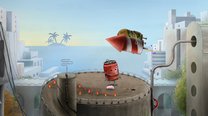

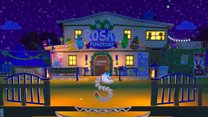

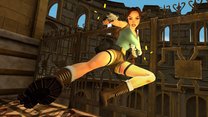

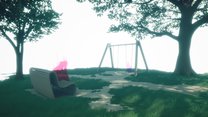
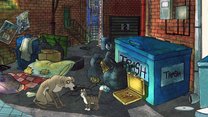
2 Comments
Want to join the discussion? Leave a comment as guest, sign in or register.
Thank you
Reply
You well articulated the angst I would experience playing this, thank you. The one time I saw casual mix okay in an adventure game was Drawn. Though in that case, the hidden object games didn't add anything; it was just easy enough and quick enough that it didn't get much in the way of everything else amazing about it. Meanwhile 3 Cards to Midnight had a really fun casual bent that could have worked great (hidden object that required you to use your brain to even figure out what to click on) but the story was so uninspiring.
Reply
Leave a comment